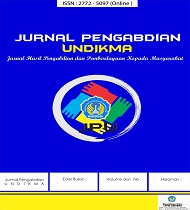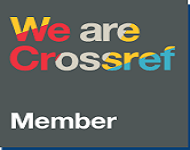Ethnomathematics Walewangko House in Project-Based Learning to Enhancing Students’ Creative Thinking and Mathematical Disposition
DOI:
https://doi.org/10.33394/jk.v10i4.13243Keywords:
Creative Thinking Skill, Ethnomathematics, Mathematical Disposition, Project Based Learning.Abstract
This research aims to examine the effectiveness of Project-based Learning (PjBL) method based on ethnomathematics of Walewangko house on students' creative thinking skills and mathematical disposition. This study employed a quantitative approach with a quasi-experimental design. The sample consists of one experimental class with 34 eighth-grade students. The research instruments included pretests and posttests on creative thinking skills as well as a mathematical disposition questionnaire, both of which have been validated for reliability and validity. Data analysis comprised descriptive and inferential statistical analyses. The inferential statistical methods used were paired sample t-tests and one-sample t-tests. The results of this study indicated that: (1) there is an improvement in students' creative thinking skills and mathematical disposition before and after the learning method was applied, (2)Â the posttest results for creative thinking skills and mathematical disposition meet the respective standard scores, (3) the percentage of classical completeness in the posttest results for both creative thinking skills and mathematical disposition exceeds 85%. It can be concluded that the Project-Based Learning method based on the ethnomathematics of Walewangko house is effective in improving students' creative thinking skills and mathematical disposition. Integration of ethnomathematics as a basis for learning, in addition to acting as a contextual learning innovation, teachers are also expected to introduce and instill in students cultural values related to the ethnomathematics used.
References
Al-Tabany, T. I.. (2017). Mendesain Model Pembelajaran Inovatif, Progresif, dan Kontekstual. Prenada Media.
Almeida, L. S., Prieto, L. P., Ferrando, M., Oliveira, E., & Ferrándiz, C. (2008). Torrance Test of Creative Thinking: The question of its construct validity. Thinking Skills and Creativity, 3(1), 53–58. https://doi.org/10.1016/j.tsc.2008.03.003
Arista, E. D. W., & Mahmudi, A. (2020). Kemampuan berpikir kreatif matematis dalam penyelesaian soal open-ended jenis PISA berdasarkan level sekolah. Pythagoras: Jurnal Pendidikan Matematika, 15(1), 87–99. https://doi.org/10.21831/pg.v15i1.34606
Astutiningtyas, L. (2017). Jurnal Math Educator Nusantara ( JMEN ) Etnomatematika Dan Pemecahan Masalah Kombinatorik. Jurnal Math Educator Nusantara (JMEN), 03(76), 110–118.
Barak, M., & Yuan, S. (2021). A cultural perspective to project-based learning and the cultivation of innovative thinking. Thinking Skills and Creativity, 39(2021). https://doi.org/10.1016/j.tsc.2020.100766
Biazus, M. de O., & Mahtari, S. (2022). The Impact of Project-Based Learning (PjBL) Model on Secondary Students’ Creative Thinking Skills. International Journal of Essential Competencies in Education, 1(1), 38–48. https://doi.org/10.36312/ijece.v1i1.752
Chen, S., Lai, C.-F., Lai, Y.-H., & Su, Y. (2019). Effect of project-based learning on development of students’ creative thinking. International Journal of Electrical Engineering & Education, 59(3), 232–250. https://doi.org/10.1177/0020720919846808
Cresswell, J. W. (2012). Educational Research : Planning, Conducting, and Evaluating Quantitative and Qualitative Research (4th ed.). Pearson.
Guo, P., Saab, N., Post, L. S., & Admiraal, W. (2020). A review of project-based learning in higher education : Student outcomes and measures. International Journal of Educational Research, 102(April), 101586. https://doi.org/10.1016/j.ijer.2020.101586
Haryanti, W., & Wijaya, A. (2023). TREN PENELITIAN DISPOSISI MATEMATIS DI SELURUH INDONESIA. AKSIOMA: Jurnal Program Studi Pendidikan Matematika, 12(1), 1167–1177. https://doi.org/https://doi.org/10.24127/ajpm.v12i1.6736
Herawaty, D., Widada, W., Novita, T., Waroka, L., & Lubis, A. N. M. T. (2018). Students’ metacognition on mathematical problem solving through ethnomathematics in Rejang Lebong, Indonesia. Journal of Physics: Conference Series, 1088. https://doi.org/10.1088/1742-6596/1088/1/012089
Hui, E. G. M. (2019). Learn R for Applied Statistics. In Learn R for Applied Statistics. Apress. https://doi.org/10.1007/978-1-4842-4200-1
Istiqomah, A., Perbowo, K. S., & Purwanto, S. E. (2018). Promoting middle school students’ mathematical creative thinking ability using scientific approach. Journal of Physics: Conference Series, 948(1), 12032. https://doi.org/10.1088/1742-6596/948/1/012032
Kemendikbud. (2023). Rapor Pendidikan Indonesia tahun 2023. https://raporpendidikan.kemdikbud.go.id/login . Diakses pada tanggal 10 November 2023
Lestari, S. D., Kartono, & Mulyono. (2019). Mathematical Literacy Ability and Mathematical Disposition on Team Assisted Individualization Learning with RME Approach and Recitation. Unnes Journal of Mathematics Education Research, 8(2), 157–164. https://journal.unnes.ac.id/sju/index.php/ujmer/article/view/27295
Maryati, & Prahmana, R. C. I. (2019). Ethnomathematics: Exploration of the muntuk community. International Journal of Scientific and Technology Research, 8(6), 47–49.
Medyasari, L. T., Zaenuri, Z., Dewi, N. R., & Wijayanti, K. (2022). Analysis of High School Students’ Mathematical Creative Thinking Ability Levels in Solving Mathematical Problems. International Conference on Science, Education, and Technology, 8(1 SE-1201–1300), 1230–1236. https://proceeding.unnes.ac.id/index.php/ISET/article/view/1890
NCTM. (2024). The intersection of culture and mathematics: A position of the National Council of Teachers of Mathematics. Cultural Studies of Science Education, 8(4), 2022–2025.
Nitko, A. J., & Brookhart, S. M. (2011). Educational Assesment of Student. Pearson.
OECD. (2019). Framework for the Assessment of Creative Thinking in PISA 2021: Third Draft. https://www.oecd.org/pisa/publications/PISA-2021-creative-thinking-framework.pdf
OECD. (2023). PISA 2022 RESULTS: FACTSHEETS – INDONESIA. www.oecd.org/pisa
Purbaningrum, M., & Mahmudi, A. (2024). The Effect of GeoGebra-Assisted Problem-Based Learning on Students’ Mathematical Literacy Skills and Learning Motivation. AL-ISHLAH: Jurnal Pendidikan, 16(2), 1337–1350. https://doi.org/10.35445/alishlah.v16i2.4620
Purwasih, R., Maya, R., Zanthy, L. S., & Minarti, E. D. (2018). Analysis Of Mathematical And Disposition Creative Thinking Ability Of Students Through Learning Alternative Solution Worksheet. Proceedings of the 1st International Conference on Science and Technology for an Internet of Things. https://doi.org/10.4108/eai.19-10-2018.2281363
Putra, A. K., Budiyono, & Slamet, I. (2017). Mathematical disposition of junior high school students viewed from learning styles. AIP Conference Proceedings, 1868. https://doi.org/10.1063/1.4995152
Retnawati, H. (2016). ANALISIS KUANTITATIF INSTRUMEN PENELITIAN. Parama Publishing.
Rusimamto, P. W., Nurlaela, L., Sumbawati, M. S., Munoto, & Samani, M. (2019). Development of critical and creative thinking skills to increase competence of PLC programming for electrical engineering education students. IOP Conference Series: Materials Science and Engineering, 535(1), 12005. https://doi.org/10.1088/1757-899X/535/1/012005
Sahliawati, M., & Nurlaelah, E. (2020). Mathematical creative thinking ability in middle school students’. Journal of Physics: Conference Series, 1469(1), 12145. https://doi.org/10.1088/1742-6596/1469/1/012145
Sansome, E. J. (2016). Building teachers ’ pedagogy practices in reasoning , to improve students ’ dispositions towards mathematics (Issue March) [Queensland University of Technology]. https://eprints.qut.edu.au/94401/1/Elizabeth_Sansome_Thesis.pdf
SEAQIL’s Team. (2020). Project-Based Learning. SEAMEO QITEP in Language Address:
Shafa, S., Zulkardi, Z., & Putri, R. I. I. (2023). Students’ creative thinking skills in solving PISA-like mathematics problems related to quantity content. Jurnal Elemen, 9(1), 271–282. https://doi.org/10.29408/jel.v9i1.6975
Sugiyono. (2019). Metode Penelitian Kuantitatif (Cetakan 2). Alfabeta.
Tim Direktorat Pembinaan SMP. (2017). Panduan Penilaian oleh Pendidik dan Satuan Pendidikan Sekolah Menengah Pertama. In Kemendikbud RI. Kementerian Pendidikan dan Kebudayaan Direktorat Jenderal Pendidikan Dasar dan Menengah. http://repositori.kemdikbud.go.id/18051/1/1. Panduan Penilaian SMP - Cetakan Keempat 2017.pdf
Trianto. (2009). Mendesain Model Pembelajaran Inovatif-Progresif (1st ed.). Kencana Prenada Group.
Ulya, H., & Rahayu, R. (2021). Mathematical Disposition of Students in Open-Ended Learning Based on Ethnomathematics. Journal of Education Technology, 5(3), 339–345. https://doi.org/https://dx.doi.org/10.23887/jet.v5i3.33535
Utami, W. T., Marsigit, & Retnawati, H. (2021). DISPOSISI MATEMATIS MAHASISWA PGSD/PGMI DI ERA PANDEMI COVID-19. AKSIOMA: Jurnal Program Studi Pendidikan Matematika, 10(3), 1645–1657. https://doi.org/https://doi.org/10.24127/ajpm.v10i3.3852
Viro, E., Lehtonen, D., Joutsenlahti, J., & Tahvanainen, V. (2020). Teachers’ perspectives on project-based learning in mathematics and sciences. European Journal of Science and Mathematics Education, 8(1), 12–31. https://trepo.tuni.fi/bitstream/handle/10024/133279/teachers_perspectives_on_project_based.pdf?sequence=1
Widana, I. W., & Septiari, K. L. (2021). Kemampuan Berpikir Kreatif dan Hasil Belajar Matematika Siswa Kemampuan Berpikir Kreatif dan Hasil Belajar Matematika Siswa Menggunakan Model Pembelajaran Project-Based Learning Berbasis Pendekatan STEM. Jurnal Elemen, 7(1), 209–220. https://doi.org/10.29408/jel.v7i1.3031
Widoyoko, E. P. (2017). Teknik Penyusunan Instrumen Penelitian. Pustaka Belajar.
Wijaya, A. (2012). Pendidikan Matematika Realistik: Suatu Alternatif Pendekatan Pembelajaran Matematika. Graha Ilmu.
Wijaya, T. T., Zhou, Y., Ware, A., & Hermita, N. (2021). Improving the Creative Thinking Skills of the Next Generation of Mathematics Teachers Using Dynamic Mathematics Software. International Journal of Emerging Technologies in Learning, 16(13), 212–226. https://doi.org/10.3991/ijet.v16i13.21535
Yu, H. (2024). Enhancing creative cognition through project-based learning: An in-depth scholarly exploration. Heliyon, 10(6), e27706. https://doi.org/10.1016/j.heliyon.2024.e27706
Downloads
Published
How to Cite
Issue
Section
Citation Check
License
License and Publishing Agreement
In submitting the manuscript to the journal, the authors certify that:
- They are authorized by their co-authors to enter into these arrangements.
- The work described has not been formally published before, except in the form of an abstract or as part of a published lecture, review, thesis, or overlay journal.
- That it is not under consideration for publication elsewhere,
- That its publication has been approved by all the author(s) and by the responsible authorities tacitly or explicitly of the institutes where the work has been carried out.
- They secure the right to reproduce any material that has already been published or copyrighted elsewhere.
- They agree to the following license and publishing agreement.
Copyright
Authors who publish with JK agree to the following terms:
- Authors retain copyright and grant the journal right of first publication with the work simultaneously licensed under a Creative Commons Attribution License (CC BY-SA 4.0) that allows others to share the work with an acknowledgment of the work's authorship and initial publication in this journal.
- Authors are able to enter into separate, additional contractual arrangements for the non-exclusive distribution of the journal's published version of the work (e.g., post it to an institutional repository or publish it in a book), with an acknowledgment of its initial publication in this journal.
- Authors are permitted and encouraged to post their work online (e.g., in institutional repositories or on their website) prior to and during the submission process, as it can lead to productive exchanges, as well as earlier and greater citation of published work.
Licensing for Data Publication
-
Open Data Commons Attribution License, http://www.opendatacommons.org/licenses/by/1.0/ (default)

This work is licensed under a Creative Commons Attribution-ShareAlike 4.0 International License.







